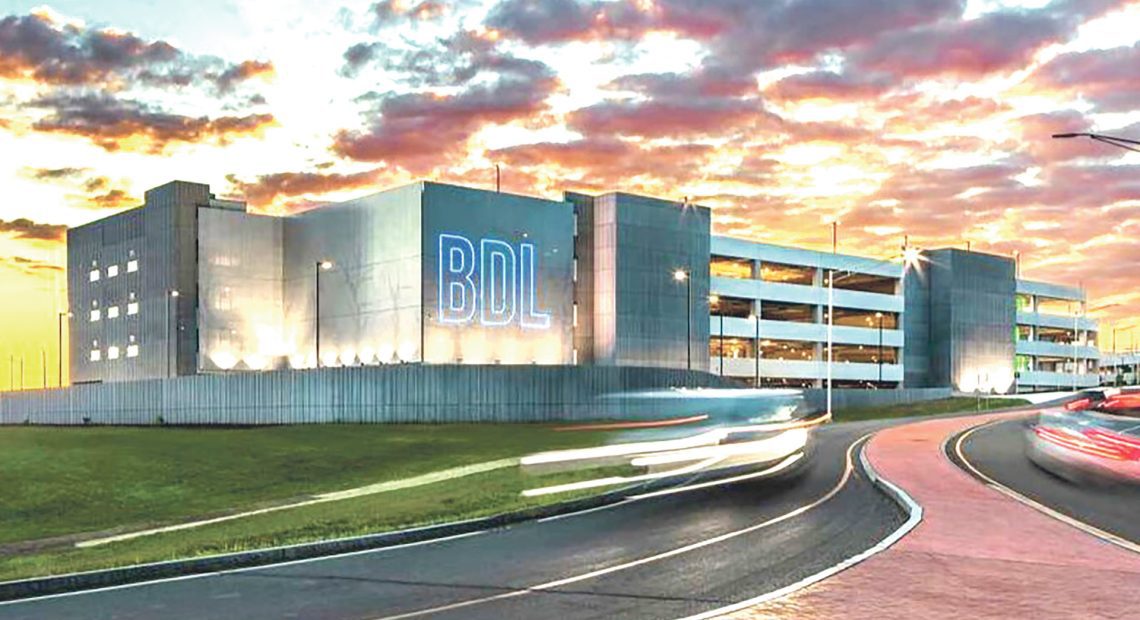Final Approach

Kevin Dillon says Bradley has made great strides over the past decade and has the potential to eventually welcome 10 million passengers per year.
Kevin Dillon will be retiring from his position as executive director of the Connecticut Airport Authority (CAA) in January, after 12 years in that job and a half-century in the aviation industry.
As he talked with BusinessWest late last month for what will likely be the last time in his tenure, he listed a number of accomplishments and milestones during his stint — everything from sharp increases in the number of carriers and non-stop flights at Bradley International Airport (12 and 47 are the current numbers) to the addition of trans-continental and trans-Atlantic flights; from the completion of the airport’s $210 million ground transportation center to the recent kickoff of $250 million worth of additional improvements to BDL.
“We’ve accomplished most of the goals we set down when we established the airport authority,” Dillon said. “Certainly the re-establishment of trans-Atlantic and trans-continental service was a very high priority for us, and we’ve been able to accomplish that with our Aer Lingus service and our LAX and other California service that we’ve had over the years.”
But he spent far more time with what has become his favorite subject — where this airport, the second-largest in New England, can go from here, building on the momentum gained over the past dozen years and the solid foundation that’s been built.
Indeed, Dillon has talked often over the years about Bradley reaching 10 million passengers per year (the current number is about 7 million) and what it will take to get there.
Specifically, it will take more of what the roughly 2.8 million people living and working in Bradley’s catchment area (mostly those within an hour’s drive from Windsor Locks) are looking for — more carriers, more flights, and especially more non-stop flights to more places, in this country and beyond.
Kevin Dillon
“Business travel hasn’t come back to the level it was pre-pandemic. And that’s a question mark across the country; will the business ever get back to that level?”
Bradley was making considerable progress in these efforts, increasing passenger volume from just under 6 million to 7 million, before significant headwinds, in the form of the pandemic and its after-effects, set things back, as they did at airports across the country.
But slowly but surely, as air travel has recovered in dramatic fashion and Bradley has added more non-stops via carriers such as Breeze and, most recently, Avelo, the airport is back to roughly where it was before the pandemic, Dillon told BusinessWest.
“We’re turning over an airport that still has tremendous opportunity and potential in front of it,” he said. “Right now, we’re back to where we were before the pandemic, and we’re back on that growth mode. I certainly believe that the next person coming in has a real opportunity to bring that airport passenger count to that 10 million level.”
As it looks to make continued progress, the airport, as it eyes nonstops to London and other popular destinations, is facing enormous competition from every other airport looking to grow its numbers, he went on. Meanwhile, the carriers have only so many planes.
“We’re in competition with every other airport in the country for the airline assets,” he said. “Every airport is trying to convince airlines to put flights into their airport; we compete with every airport in the region for passengers, but we compete with every airport in the country for airline assets.”
Then there’s the still-sluggish business-travel market, which is an important part of the equation at Bradley, where, before the pandemic, roughly half the passenger volume was business-oriented — a high percentage for an airport of this size — and now, it’s closer to 40%.
“Business travel hasn’t come back to the level it was pre-pandemic,” he said. “And that’s a question mark across the country; will the business ever get back to that level?”
Overall, Dillon is bullish on Bradley and believes it has all the ingredients to become an even more popular alternative to Logan in Boston and the airports in and around New York. For this issue’s focus on travel and tourism, he talked about how to, well, get there from here.
Plane Speaking
Dillon became the first executive director of the CAA after its formation by state officials more than a dozen years ago in an effort to help Connecticut’s airports, and especially Bradley, reach their full potential.
“We’ve demonstrated time and time again that, if we have non-stop service to a location, we will capture at least 80% of everyone in our core area that’s looking to travel to that location.”
Prior to that, he had worked at several different airports and in various capacities, starting with more than 20 years with the Port Authority of New York and New Jersey, with his last assignment as acting general manager of LaGuardia Airport. Later, he served the Massachusetts Port Authority as director of Aviation Operations before working in Manchester, N.H. as director of its airport, in Orlando, and then as president and CEO of the Rhode Island Airport Corp., before taking the helm at the CAA in 2012.
As noted earlier, his time at Bradley has been marked by a number of accomplishments, including a doubling of non-stop flight destinations, the addition of several new carriers, an economic impact to the region of just under $4 billion, and several capital improvements.
These include upgrades to the terminal building, including $250 million in ongoing work, including an in-line baggage-check system that will also bring two additional gates to the airport, which are sorely needed as it continues to grow.
There’s also a vertical-circulation project that will change the way travelers move through the building, allowing the airport to expand its security checkpoint, Dillon explained, adding that these improvements will effectively extend the useful life of the terminal building.
Some of the biggest steps forward, though, have come with the adding of new carriers, especially those in the “ultra-low-cost” category, as he called it, which are in demand among consumers.
Such carriers include Breeze (which has made Bradley a hub), Frontier, Spirit, and, most recently, Houston-based Avelo, which will start service from Bradley to Cancun; Montego Bay; Jamaica; Charlotte/Concord, N.C.; Daytona Beach and Orlando, Fla.; Houston; and other destinations starting in November.
“That’s a level of carrier that didn’t really exist when the CAA was first created,” he noted, adding that, at the time, Bradley had most of the mainstream carriers — Delta, United, Southwest, and others — and has since has put a hard focus on the lower-cost carriers, “because we saw that’s what the marketplace was looking for, and it has really fueled a lot of the growth here at Bradley as well.”
Another key is the addition of more non-stop flights, which are also in demand among consumers, Dillon said, adding that the total is now at 47 and certain to climb higher. Many of them are to Florida, courtesy of Breeze, JetBlue, Southwest, and Spirit, he said, adding that such flights are popular and integral to the overall success of any airport in the Northeast.
“We know where people in our catchment area are flying to and what airport they’re using to do that — so it’s a matter of aggregating that data and then presenting it to an airline and making the business case for why an airline should start that level of service at Bradley.”
“We’re thrilled to see this level of coverage down into the Florida market,” he said. “It’s what allows us to continue to keep people in our market home instead of seeing them travel to a New York airport or Boston.”
Non-stop Action
These initiatives and others have positioned Bradley for continued growth, Dillon believes, adding that the priorities moving forward are to stress Bradley’s many assets while continuing to add more services to the mix.
Doing so will enable the airport to draw more customers from within that 60-minute-drive circle, while also perhaps expanding that radius, making Bradley an attractive alternative for people in various regions.
That includes Western Mass., the source of perhaps 20% of Bradley’s overall passenger volume, he said, adding that the 413 is definitely a potential source of additional growth, as is the area just east and south of Worcester — and Connecticut, for that matter, he said.
One of the priorities — and opportunities — moving forward is adding non-stop service to London, a key destination and part of the success quotient for any large airport.
“Far and away, I think London would be the most successful trans-Atlantic service for us, simply because of the high level of demand into London itself, but also all of the connectivity opportunities that exist,” he said, adding that Bradley has been in discussions with British Airways and other carriers about such service.
It would come with a certain amount of risk at mid-size airports such as Bradley, he went on, adding that, because of this, airlines look for revenue guarantees and/or business-community commitments that will guarantee a certain amount of revenue on the flight.
“There’s always risk when you start a service like that,” Dillon said. “But I do believe, based on the numbers we’re generating every day in the market area that we serve, of people who are traveling to London, that it would be a very successful service.”
Other priorities include additional non-stop flights to spots in the Caribbean and this country, including Seattle, an increasingly popular destination.
With more non-stops, the airport can, as he noted earlier, attract more people in its main catchment area.
“We’ve demonstrated time and time again that, if we have non-stop service to a location, we will capture at least 80% of everyone in our core area that’s looking to travel to that location,” Dillon said, adding that this bodes well for carriers looking to accept the risk of bringing more of these flights to Bradley.
“If we can bring Seattle service to Bradley, people are going to stay home and utilize Bradley for that service,” he went on. “Today, if you want a non-stop service into Seattle, you have to go to either Boston or New York. We have a lot of data available to us; we know where people in our catchment area are flying to and what airport they’re using to do that — so it’s a matter of aggregating that data and then presenting it to an airline and making the business case for why an airline should start that level of service at Bradley.”
Strong levels of business travel always help an airport make its case, he continued, adding that Bradley has historically been blessed with that quality. Thus, the future of business travel will be one of the factors determining the overall trajectory of its growth pattern.
Overall, many factors will ultimately decide where Bradley goes from here. And as Dillon prepares to step into retirement, he believes he’s helped put the airport on the proper flight path.







